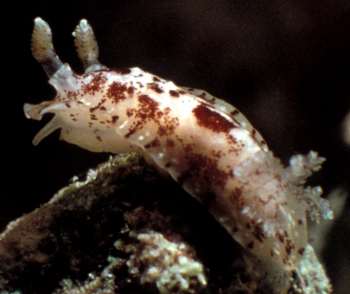
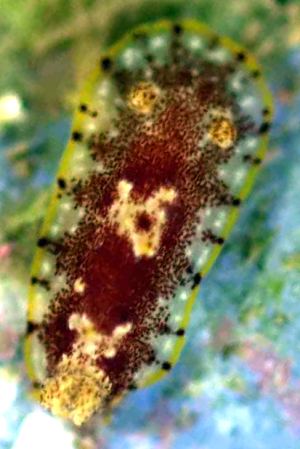
Aphelodoris antillensis
Bergh, 1879
Order: NUDIBRANCHIA
Suborder: DORIDINA
Superfamily: EUDORIDOIDEA
Family: Dorididae
DISTRIBUTION
Caribbean Sea
PHOTO
Upper: Lucaya, Grand Bahama Island, Bahamas, 1979. Photo: Lindsay Warren. Lower: Santa Marta (rocky shore), Colombia, Caribbean coast. 7 mm long alive, Photo: Nestor E. Ardila.
Originally described from a preserved specimen, Hamann (1992) described the colour variation to be found in this species. The background colour is translucent clear, and the viscera shows through in the central region as a pale orange or pinkish tinge. There rest of the mantle is covered with opaque white and dark brown spots, the dark brown spots often aggregated into larger patches. Around the mantle edge there a dark brown lines or linear patches arrange at right anles to the edge. In some specimens there is a yellow border. The translucent white body and foot also has dark brown spots. The white-tipped, lamellate rhinophores are yellowish, with a few spots of brown, and are able to retract into a raised sheath. The five thickened gills are also yellowish, becoming white at the tips, and are sparsely spotted with brown. grows to about 3cm in length.
Reference:
• Bergh, L. S. R. 1879. Neue Chromodoriden. Malakozoologische Blatter, NF 1: 87-116, pl. IV.
• Hamann, J.C. (1992) A warm water Atlantic synonymy, Aphelodoris antillensis equals Chromodoris bistellata (Opisthobranchia: Gastropoda). The Veliger, 35(3): 215-221.
• Marcus, Er., & Ev. Marcus. (1970) Opisthobranchs from Curacao and faunistically related regions. Studies on the fauna of Curacao and other Caribbean Islands, 33(122): 1-129.
• Redfern, C. (2001) Bahamian Seashells: A thousand species from Abaco, Bahamas. Bahamianseashells.com, Inc.: Boca Raton, Florida.
Rudman, W.B., 2003 (February 27) Aphelodoris antillensis Bergh, 1879. [In] Sea Slug Forum. Australian Museum, Sydney. Available from http://www.seaslugforum.net/find/apheanti
Related messages
Aphelodoris antillensis from the Bahamas
July 9, 2004
From: Lindsay Warren

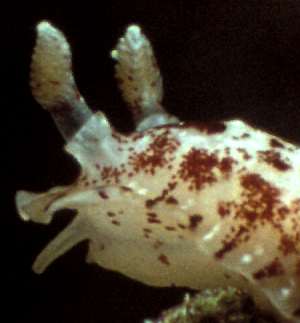
Dear Bill
I thought you might like this shot of what I believe to be Aphelodoris antillensis. I photographed it in the latter part of 1979 in Lucaya, Grand Bahama Island, Bahamas. Unfortunately I do not have any details as to depth found or its length. However judging from the size of its rhinophores in relation to the size of its body and the branchial plume being fairly small, I suspect that it is a juvenile and quite small. It's not great shakes as a photo but at least one can see the rhinophore type pretty clearly.
All the best
Lindsay
alldcl@compuserve.com
Warren, L., 2004 (Jul 9) Aphelodoris antillensis from the Bahamas. [Message in] Sea Slug Forum. Australian Museum, Sydney. Available from http://www.seaslugforum.net/find/12681Thanks Lindsay,
This certainly looks to be a more 'typical' colour form of the species than the one we have on the Forum [m9286]. I have included a close-up of the naterior end to show the raised rhinophore pockets and the apparent white mantle glands around the mantle edge.
Best wishes
Bill Rudman
Aphelodoris antillensis from Colombia
March 2, 2003
From: Nestor E. Ardila

Dear Bill,
Here are some photos of a specimen of Aphelodoris antillensis Bergh, 1879 which was collected manually, in Santa Marta (rocky shore), Colombia, Caribbean coast. It was 7 mm long alive. I have also sent photos of the radula and lateral view too. I didn't see pictures of this species in the Forum.
Thanks in advance!!
Nestor
nardila@invemar.org.co
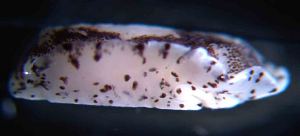
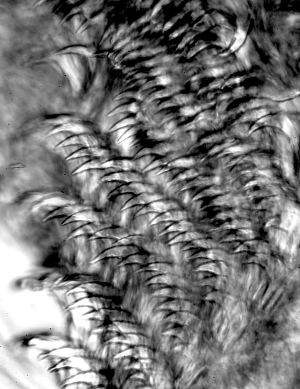
Thanks Nestor,
Like many Caribbean species, we don't know much about Aphelodoris antillensis. It is possible the yellow border in your animal is a juvenile characteristic.
Best wishes,
Bill Rudman
